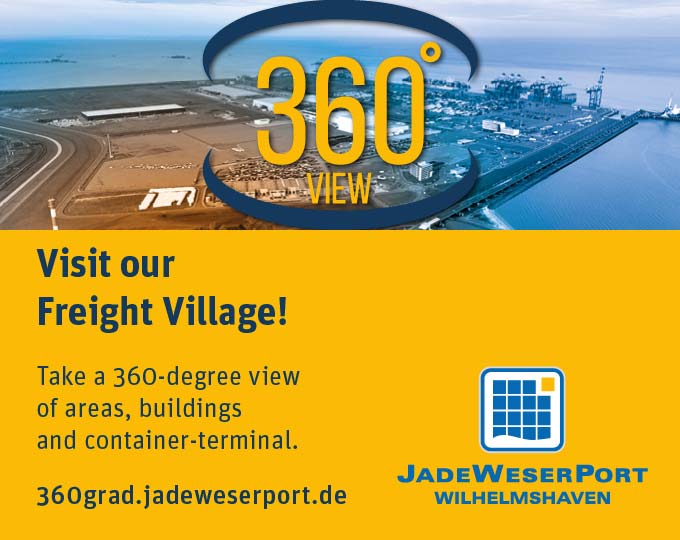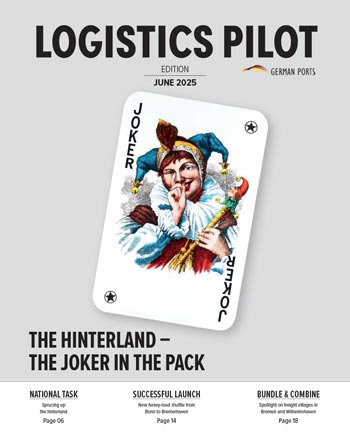Despite declining figures, inland navigation aims to find its way back on the route to success with a comprehensive set of measures. A lot is happening, especially in the Weser drainage basin.
Photos: Wasserstraßen- und Schifffahrtsverwaltung des Bundes, Senatorin für Wissenschaft und Häfen, Bremen
7.8 per cent in 2018. In comparison: In 2013 it was still 9.3 per cent. “In 2018, the low water level hampered us,” was the brief conclusion of numerous market players.
Around the ports of Bremen this problem did not exist. Consequently, the number of inland waterway vessels handled in Bremen and Bremerhaven in 2018 was 8,301 according to Hafenspiegel – and thus exceeded 8,000 again for the first time after 2012. The volume of 5,215,000 tonnes handled there in 2018 was also the highest since 2014. For 2019, however, a slight downward trend was also expected in terms of the volumes handled. “One of the main reasons for this trend is likely to have been the action taken by the shipping consortium The Alliance to transfer four of its transatlantic lines from Bremerhaven to Hamburg at the beginning of 2019,” says Cordula Radtke, authorised signatory at Weser Container Xpress, a subsidiary of the Rhine-Umschlag corporate group from Oldenburg, which operates inland waterway container services in Northwest Germany. From her point of view, this step also resulted in the loss of a large amount of cargo for hinterland transport in the region and thus for inland navigation.
Note: most environmentally friendly transport mode!
“Unfortunately, the volume of traffic in Bremen’s ports is following the federal trend, which shows that the Federal Government’s transport policy plea for greater use of inland waterway transport has not yet been heard,” Andrea Vasterling-Will, consultant to the Senator for Science and Ports in Bremen, sheds light on the current situation. With this in mind, both Vasterling-Will and Radtke point out that inland waterway transport is the most environmentally friendly mode of transport and that the existing potential is far from being fully utilised, especially when it comes to shifting traffic from road and rail. “Therefore, further efforts by the Federal Government and the States are still needed to promote inland waterway transport,” according to Vasterling-Will. For this reason, Bremen welcomed the set of measures presented as part of the Inland Waterway Transport Master Plan, which was presented by the Federal Ministry of Transport and Digital Infrastructure (BMVI) in Berlin in May 2019 and in which representatives from numerous sectors of the maritime industry participated.
Highs and lows
Jörg Huber, head of the subdivision Waterway Management in the Federal Waterways and Shipping Administration (WSV), considers it an important success on the chosen path that it has been possible since 2018 for large inland waterway vessels of up to 110 metres in length to sail from Bremen to the Middle Weser and thus reach the important inland ports in Germany via the Mittelland Canal. At the same time, he sees the current state of development of the Middle Weser, the Hunte River and the coastal canal as one of the main reasons why it is at present difficult for the local inland navigation sector to offer shippers a competitive transport service. “We still have a lot of work to do. I am thinking in particular of the riverbank relocations to be carried out as part of the Middle Weser expansion. These are to be completed by 2022,” says Huber. “At the same time, the lay-by basins of the Langwedel, Schlüsselburg, Landesbergen, Drakenburg and Petershagen locks are being upgraded one after the other and extended for large motorised cargo vessels. In addition, the upper sluice channel of the Dörverden lock will be modified,” he describes the most important measures for the Weser drainage basin.
In turn, Radtke considers the relocation of the Middle Weser riverbanks and the construction of new locks in Minden and Dörverden to be “a step in the right direction”. “Among other things, a further step must now be taken to adjust the opening hours of the locks on the Middle Weser for Sundays and public holidays to the opening hours during the week in order to avoid corresponding bottleneck effects,” she demands. Background information: The locks on the Middle Weser and the coastal canal are operated in a two-shift system and are open Monday to Saturday from 6 a.m. to 10 p.m., but only from 8 a.m. to 4 p.m. on Sundays and not at all on public holidays. Both the WSV and the Bremen Senate want to create more flexibility for shipping by building new control centres. “We are equally positive about the telecommunications centre in Minden that was planned by the Federal Government and is currently being implemented. In future, all locks on the Middle Weser as well as in Minden and the Osnabrück branch canal will be switched from there,” says Vasterling-Will. Regioport Minden, a newly built port with a bimodal connection in the first subsection of the Mittelland Canal near Minden, also plays an important role in the optimisation plans of the Bremen Senate. “Regular meetings with representatives of the states of Lower Saxony and North Rhine-Westphalia serve to establish and implement their common interests in an efficient Middle Weser with regard to regioport Minden as the hinterland location of Bremen’s ports,” Vasterling-Will goes on to summarise the current situation.
Most read
More competitiveness by means of digitalisation
All three interviewees are in agreement that inland navigation will most certainly benefit from digitalisation and thereby further increase its competitiveness. Two projects are of particular importance from Bremen’s point of view: the project “Binntelligent – Intelligent Information Technologies for Process Optimisation and Automation in Inland Ports”, which was launched in October 2018, and the project “IWTS 2.0 – Inland Waterway Transport Solutions”, funded by the European Union. The first project aims to digitise the coordination between the various participants in the transport chain, also by making use of AIS and lock data, in order to increase the predictability for inland ports and inland navigation with regard to transport routes and transhipment. To this end, various intelligent information technologies are to be simulated, developed and field-tested. Within the framework of the second project, in which bremenports is also actively involved, innovative solutions for cargo handling with inland vessels are to be developed over the course of the next three years. The project simultaneously seeks to strengthen inland navigation in the curricula of vocational training institutions and to transform students and young entrepreneurs into ambassadors of inland navigation. A so-called “innovation lab” will be the core element, which will enable the target groups to develop digital tools for inland navigation. Their ideas can span various domains: from simulation, planning and monitoring instruments to data analysis and controlling applications through to intelligent information systems.
Maximising potential
Incidentally: When Andreas Scheuer, Federal Minister of Transport and Digital Infrastructure, presented the master plan for inland navigation, he remarked: “The inland vessel is a stealthy freight transport giant – powerful, safe and efficient. With a carrying capacity of 3,000 tonnes, these motorised cargo vessels can replace up to 150 trucks. This is an enormous amount of potential and we want to make even better use of it.” The next few years will reveal the extent to which this will succeed. “We must drastically increase the share of inland navigation in the modal split in the North German ports; the western ports have been doing this successfully for years,” Radtke points the way forward: “Because seaports are only ever as good as their hinterland connections.” (bre)
More Information
Logistics Pilot
The current print edition - request it now free of charge.







